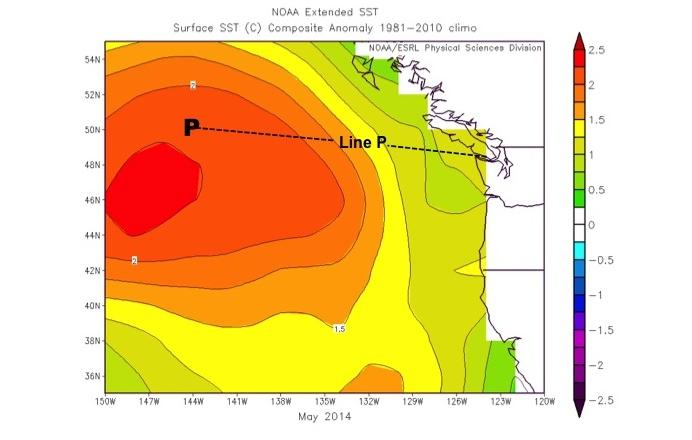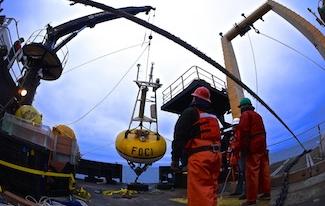What's Happening Archive
Deep Sea Research Part II just published a special issue on research in the Bering Sea. Ten PMEL and Joint Institute for the Study of Atmosphere and Ocean scientists contributed to this issue. The Bering Sea Project: Volume III documents the findings of six years of research and the partnership of two ecosystem programs.
The NSF-funded Bering Ecosystem Study (BEST) and the NPRB-funded Bering Sea Integrated Ecosystem Research Program (BSIERP), with in-kind contributions from NOAA and the US Fish and Wildlife Service, have shed light on ecosystem dynamics and how the region may respond to climate change. In particular, researchers found that when and where the sea ice extends are major factors that determine productivity and impact the entire ecosystem of the Bering Sea. To find out more information about these exciting programs, visit the EcoFOCI and BEST-BSIERP websites.
PMEL and Alaska Fisheries Science Center scientists have observed and sampled a large coccolithophore bloom, viewable even from space, in the Eastern Bering Sea during a recent October EcoFOCI research cruise. This phytoplankton bloom is caused by the coccolithophore, Emiliania huxleyi, a one-celled marine algae with calcite plating, and has persisted for nearly three months, starting in July 2014. Blooms of this size and duration have not been seen for over a decade in the Bering Sea.
The satellite image from September 26 shows the aquamarine bloom with the white circles indicating sampling stations occupied by NOAA’s research vessel Oscar Dyson during the cruise. For more information please visit the EcoFOCI cruise website.
Researchers at PMEL and JISAO are monitoring an area of warm surface water that has been occupying the Northeast Pacific near Ocean Climate Station Papa buoy. This mass of water, nicknamed “The Blob”, was about 3 degrees Celsius warmer than normal in February and is maintaining its abnormal heat into the summer. The warm water has implications for the marine ecosystem and could affect the weather in the Pacific Northwest. Past summers with especially warm water off the coast have tended to be warmer and more humid than usual.
To check out the latest conditions with The Blob, visit the Ocean Climate Station Papa buoy page.
In a study published January 30 in Geophysical Research Letters, a multi-disciplinary team of researchers that included PMEL’s Phyllis Stabeno and Dave Mellinger described integrated biophysical data “from wind to whales” in the Southeast Bering Sea. Distinct patterns in production, zooplankton biovolume and the occurrence of zooplankton predators such as fin and right whales were related to discrete features in the annual physical cycle.
For more information on the EcoFOCI Program, please visit their website.
Scientists from PMEL's Fisheries Oceanography program are cruising the Bering Sea from April 23-May 3 for the first mooring cruise of the spring season. Aboard the NOAA research ship Oscar Dyson, they are in Alaskan waters to retrieve and redeploy moorings, collect CTD (conductivity-temperature-depth) and other data.
You can follow the cruise and see pictures from the Bering Sea on the Research Mooring Cruise to the Bering Sea web page.
Five scientists from PMEL's Fisheries Oceanography program are on board the University of Washington R/V Thompson from May 9 to June 14 as part of the fourth in a series of annual spring cruises through the NSF-BEST and NPRB-BSIERP programs. PMEL is handling hydrography, water sampling, nutrient and O2 analysis, and ice sampling.
To follow this expedition as it travels the Bering Sea please visit the EcoFOCI web site.
EcoFOCI is heading far north to the Chukchi Sea (August 16-September 20) to deploy moorings that will over-winter under the ice to monitor ecosystem changes for the first time in the region. At three different sites in the Chukchi Sea, EcoFOCI will deploy subsurface moorings that will measure ice thickness, currents, zooplankton, light, nitrate and other important indicators of ecosystem health.
EcoFOCI has an interest in obtaining ice-thickness measurements that will improve the understanding of ice cover, including its thickness, persistence and transport.
Scientists from PMEL’s Ecosystems & Fisheries-Oceanography Coordinated Investigations (EcoFOCI) group set sail on April 30 for the first major cruise of Gulf of Alaska Integrated Ecosystem Research Program (GOA-IERP). Led by PMEL's Dr. Nancy Kachel, EcoFOCI and GOA-IERP will look at oceanographic and climate influences, and relationships between trophic levels in a changing ecosystem and will include zooplankton sampling, hydrographic measurements, water and iron sampling.
For more information on this expedition please visit the EcoFOCI cruise website.
Bering Sea marine mammals, birds, and fish are shifting where they eat, bear their young, and make their homes in response to changes in sea ice extent and duration. These patterns of change are documented in a special issue of the journal of Deep Sea Research II now available online with many authors from PMEL’s Ecosystem & Fisheries-Oceanography Coordinated Investigations program.
You can read more on the NOAA press release.
PMEL and Alaska Fisheries Science Center’s EcoFOCI program just deployed the M2 mooring in the southeastern Bering Sea for the 20th consecutive year. The mooring has been providing year-round measurements of temperature, salinity, nitrite, chlorophyll, and currents in this highly productive area since 1994. These measurements are used in annual report cards and stock assessments provided to the North Pacific Fishery Management Council. Long-term time-series at this site are a critical tool for adapting to climate change and guiding sustainable management of living resources in the Bering Sea.
Visit the EcoFOCI website for more information on their work in the Bering Sea, Gulf of Alaska, and Arctic waters.





